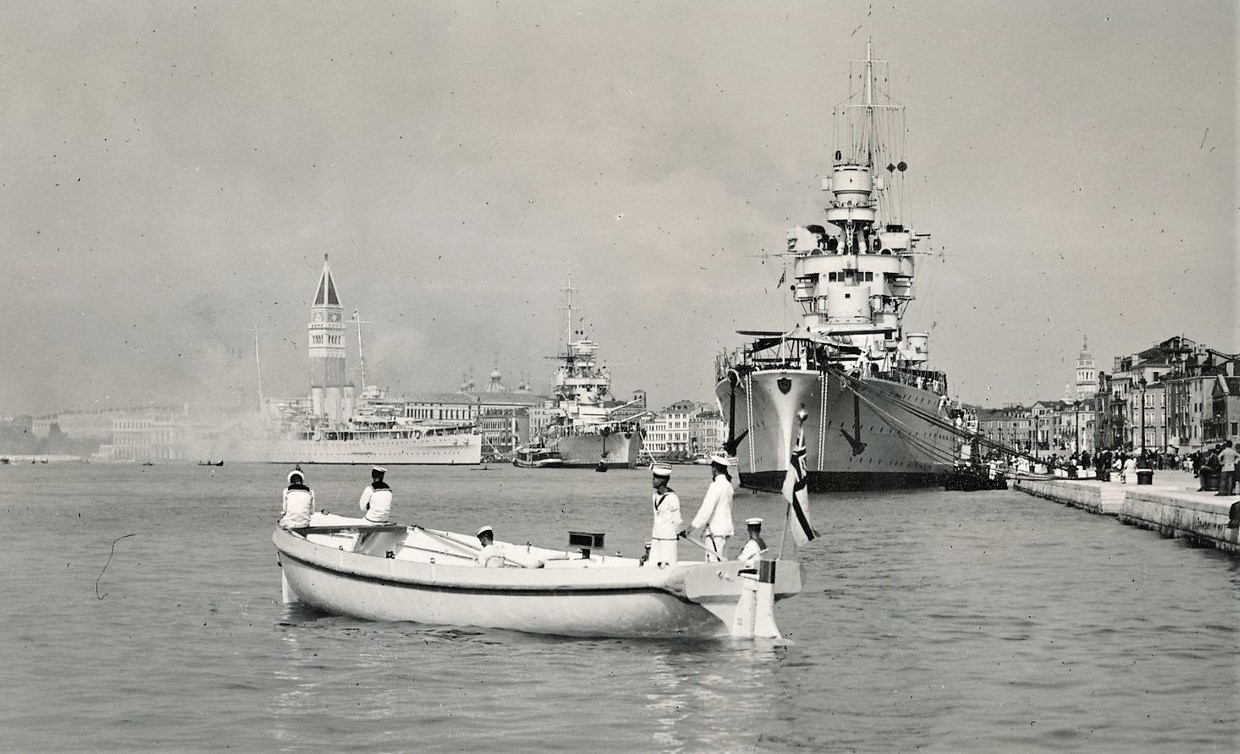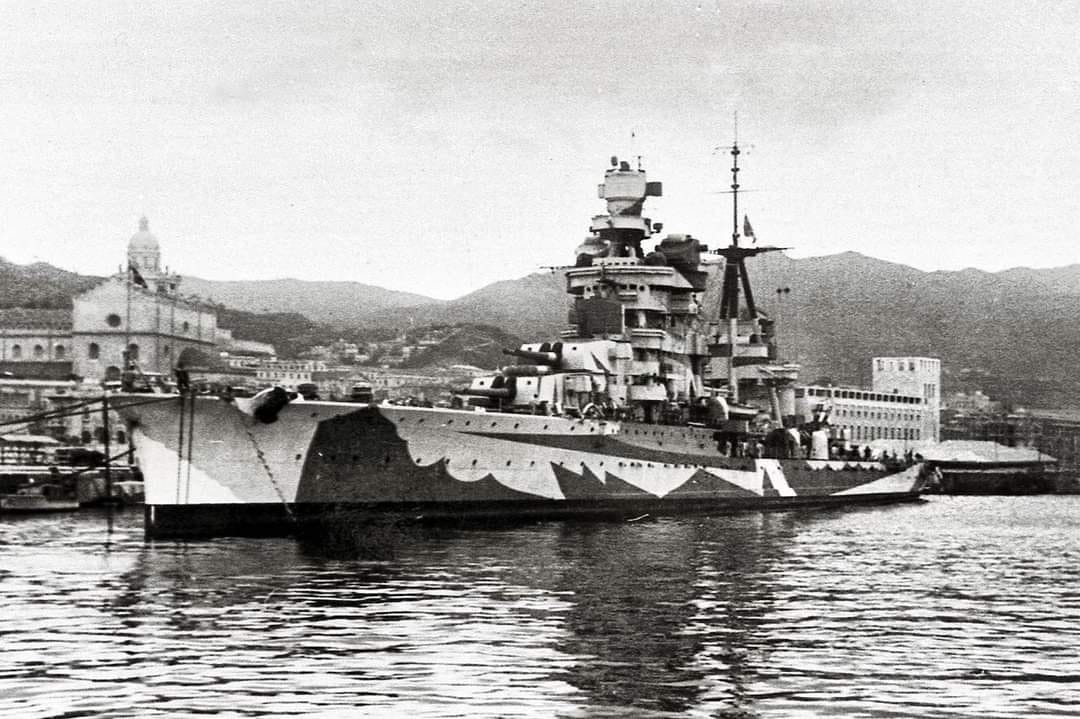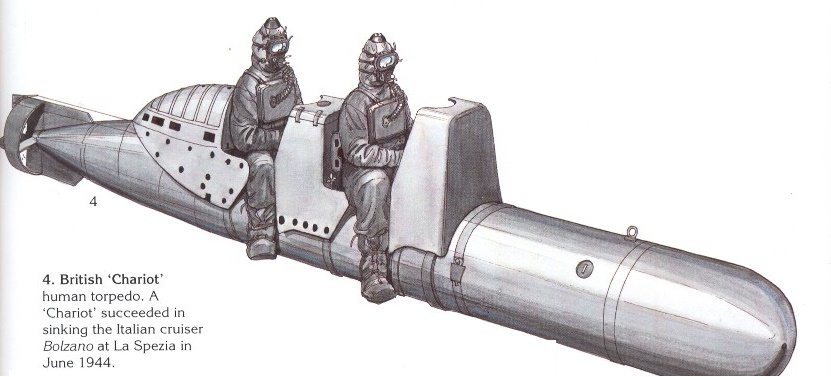Warship Wednesday, July 21, 2021: Luckiest of the Italian Heavies
Here at LSOZI, we take off every Wednesday for a look at the old steam/diesel navies of the 1833-1954 period and will profile a different ship each week. These ships have a life, a tale all their own, which sometimes takes them to the strangest places. – Christopher Eger
Warship Wednesday, July 21, 2021: Luckiest of the Italian Heavies
Here we see the Zara-class incrociatore (heavy cruiser) Gorizia of the Regia Marina, with her sister Fiume, anchored in Venice circa September 1937. The Palazzo Ducale is in the distance to the left, where the visiting British County-class cruiser HMS London (69) rests in a place of honor pierside. Note the whaleboat in the foreground with the duster of the Royal Navy, which called on the City of Canals that summer under the flag of VADM Sir Charles Kennedy-Purvis. Of course, the British would revisit Italian harbors several times just a few years later, but under much less cordial terms, and often at night.
The four Zaras were impressive in scale, at some 599-feet in length overall, and had an “official” Naval Treaty standard weight of 10,000-tons, although their actual full load weight was closer to 14,500 tons. Using eight British pattern Thornycroft boilers and a pair of Parsons steam turbines, they could make 32 knots even with a very strong armor scheme (up to 5.9-inches) for interbellum cruisers.
The primary armament for these Italian heavies was eight 8″/53 Model 1927 Ansaldos, mounted in four twin turrets. These guns had a range of about 34,500 yards firing 270-pound AP shells and, due to the electrically-powered training and elevation and hydraulically powered rammers used in their mountings could fire as fast as 3.8 rounds per minute per gun– very respectable for the era.

Heavy cruiser Gorizia, 1941, with members of her crew clustered in front of her forward 8 inch mounts. Although excellent guns, the very tight mountings limited the spread of shell fire.
Secondary armament consisted of 16 3.9″/47 O.T.O. Model 1928 DP guns in eight twin shielded mounts. Basically, an unlicensed version of the old Austro-Hungarian Navy’s Skoda K10/K11 that the Italians fell in love with when they saw it on war prizes in 1918, O.T.O. had revamped the design into a decent AAA piece with a ceiling of 33,000 feet.
Unlike most cruisers built in the first half of the 20th Century, the Zara class did not carry any torpedoes, but they did, awkwardly, have a bow-mounted catapult for two single-engine floatplanes.
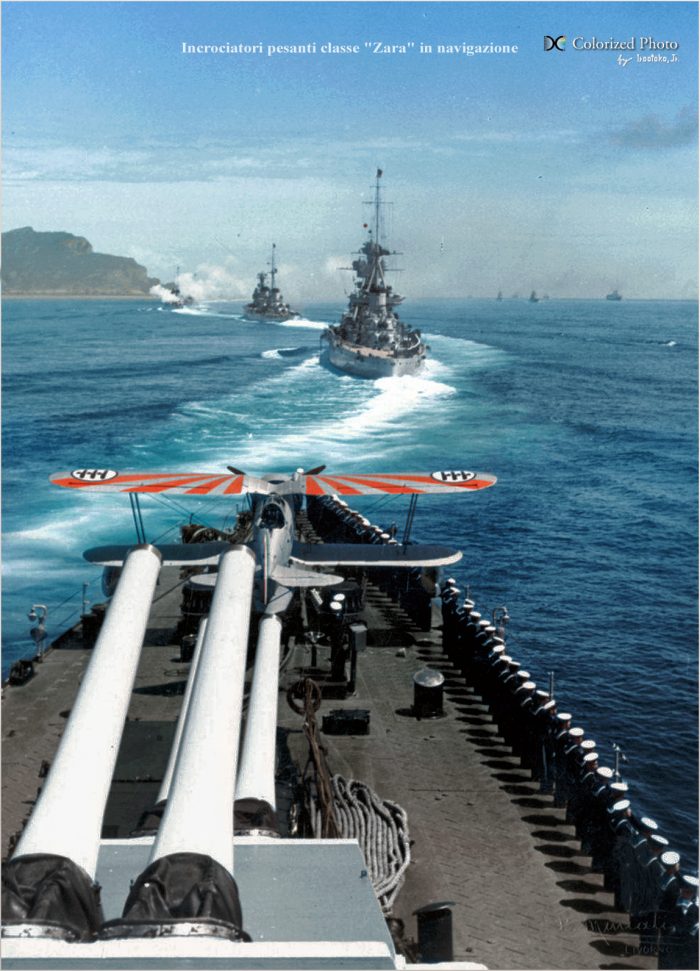
Italian heavy cruiser Zara incrociatori pesanti classe Zara in navigazione. Photographer Miniati, Bruno 1939, Alinari archives. Colorized photo by Atsushi Yamashita/Monochrome Specter http://blog.livedoor.jp/irootoko_jr/
Richard Worth, in his Fleets of World War II, notes that the Zaras had a lot of attributes that set them up for success.
They were handsome ships, dry and stable, with the most endurance among Italian cruisers (5,000+ miles at 16 knots). With 13 percent of their tonnage devoted to protection, they showed an excellent concentration of metal; only American cruisers had thicker belt armor. The guns were paired too closely but they otherwise performed well. If the Italians had persisted in designs like this one, they could have deployed a powerful fleet indeed.
Laid down at O.T.O. Livorno on 17 March 1930, Gorizia was completed just 21 months later on 23 December 1931.
The class, among the most advanced and formidable in the world during the “Treaty” era, was a favorite of the U.S. ONI, and several period photos are in the collection of the Navy Heritage Command, likely gleaned from open sources by Naval attaches in Europe before the war.

Italian ship: GORIZIA. Italy – CA (Zara class). Italian fleet in the harbor of Naples. Catalog #: NH 111423

The four Zara class heavy cruisers, seen during the late 1930s, possibly at the now-infamous May 1938 “H Review” along the Gulf of Naples in which Il Duce tried very hard to impress his little Austrian buddy with the funny mustache. The four ships are (unidentified as to order in the photograph): ZARA (1930-1941); FIUME (1930-1941); GORIZIA (1930-1944); and POLA (1931-1941). NH 86333

The Four Italian ZARA Class Heavy Cruisers at Naples. The late 1930s, all four sister cruisers at anchor from front to back: FIUME (1930-41), ZARA (1930-41), POLA (1931-41), and GORIZIA (1930-44.) NH 86432
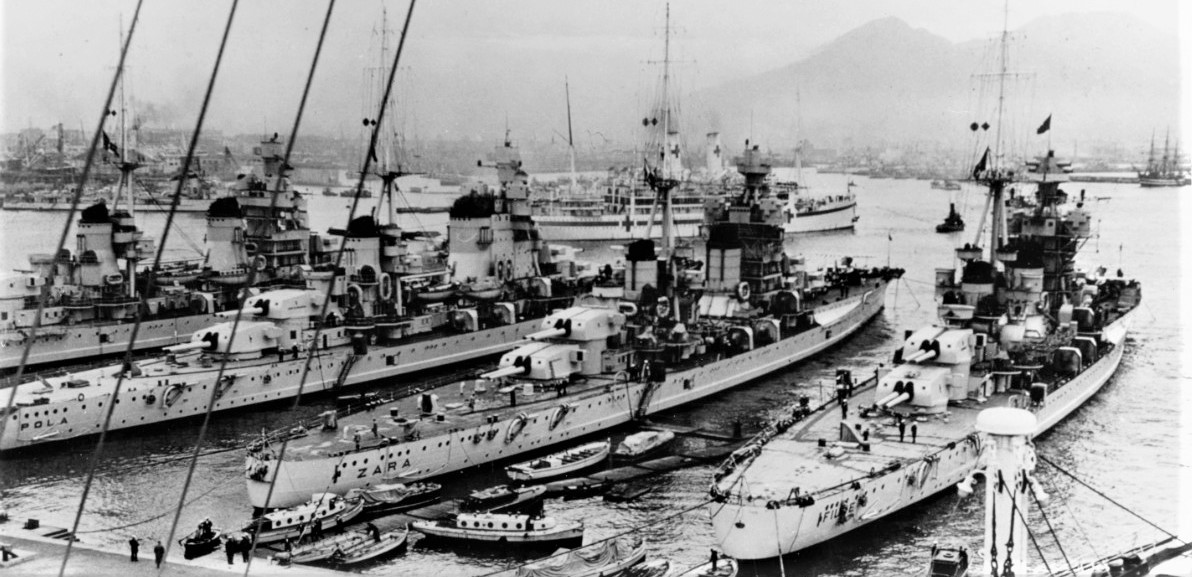
The “four sisters” of Italian heavy cruisers. From left to right: GORIZIA (1930-1944), POLA (1931-1941), ZARA (1930-1941), and FIUME (1930-1941) at Naples, circa 1938. One of the Italian Navy’s training ships, AMERIGO VESPUCCI (1930) or CRISTOFORO COLOMBO (1928), appears in the distance to the right. NH 86577

Italian ship: Heavy cruiser GORIZIA. Italy – CA (Zara class). Photographed during 1935 in the Suez Canal. NH 111424

GORIZIA (Italian Heavy Cruiser, 1930-44) Photographed at a fleet review before World War II, possibly at Naples in 1938. Three other heavy cruisers and three destroyers appear in the background. NH 86107

GORIZIA (Italian heavy cruiser, 1930-1944) Detail view of the ship forward superstructure, seen from the starboard side in a pre-World War II photograph. Note sailors waving. NH 86304
In the decade prior to WWII, the Zaras in general and Gorizia, in particular, was very busy, spending much time lending Franco a quiet hand in the Spanish Civil War, to include intercepting the fleeing Republican fleet out of Cartegena–consisting of the cruisers Miguel de Cervantes, Libertad, and Mendez Nuñez, along with eight destroyers and two submarines– in March 1939, which was desperately trying to make a friendly exile in Soviet Russia via the Black Sea. Instead, the Spanish had to settle for internment in French Tunisia where its commander, ADM Miguel Buiza, later volunteered for the French Foreign Legion, a force swelled at the time with former Republicans.
It was during the Spanish Civil War that Gorizia let the cat out of the bag on the fact of how outside of the naval treaty limits they were. While holding station off Spain in August 1936, she suffered an avgas explosion that blew out parts of her bow, forcing her to put into British Gibraltar for emergency repairs.
There, dockyard workers and RN personnel were easily able to ascertain that she was grossly overweight and up-armored from her “public” specs and quietly reported it up the chain, although the British Foreign Secretary, Anthony Eden, never took up the matter with Rome.
In another prelude to the Big Show, Gorizia accompanied the rest of her class to help support the quickly accomplished Italian invasion of Albania in April 1939 while the British fleet, a force that saw itself as the Lion of the Med, was infamously “lolling about in Italian harbors.”
The Main Event
When Italy entered WWII against France and Britain as one of the Axis Powers in June 1940, the Zara class was in for a wild ride.

Italian battlefleet off Gaeta in 1940 showing four Zara class cruisers, two Trento class cruisers, and Bolzano
The very next month, the four sisters managed to come out of the Battle of Calabria against the British fleet without damage and, that November, were all clustered in Taranto when British Swordfish torpedo bombers famously penetrated the harbor and smacked around the Italian battleships, again surviving without a scratch. In the follow-on Battle of Capo Teulada, Gorizia fired a dozen salvos and bird-dogged the British squadron with her seaplanes, with no real effect on either side.
Gorizia’s luck continued to hold when, missing the Battle of Cape Matapan in March 1941 as she was escorting convoys to Libya, all three of her sisters, Pola, Zara, and Fiume, were sacrificed needlessly to the guns of British battleships, with horrendous loss of life. All that 5.9-inch plate was of no use against point-blank hits from 15-inch guns, it turned out, a lesson the Brits had previously handed out to Von Spee’s squadron in the Falklands in 1914.
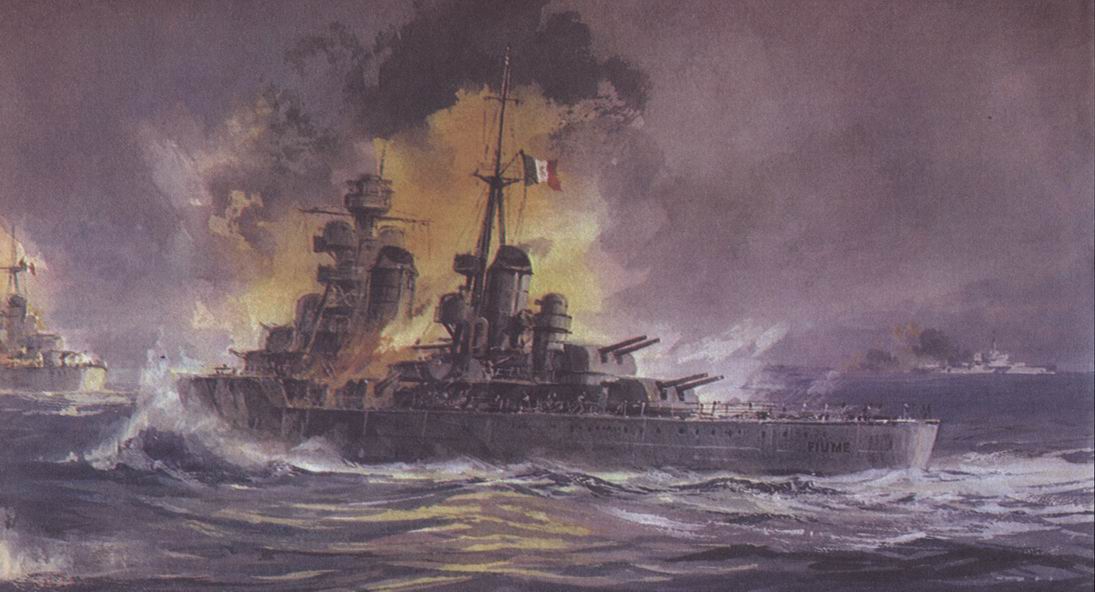
Fiume, a Zara-class heavy cruiser sunk during Battle of Cape Matapan, 29 March 1941, painting by Adam Werka
The only survivor of her class, Gorizia fought at both inconclusive surface actions known as the battles of Sirte, again without taking hits in either.
The U.S. Navy’s ONI 202 listing for Italian ships, released in early 1942, carried Gorizia.
Endgame
Her luck ran out on 10 April 1943.
The last two operational Italian heavy cruisers, Gorizia, and the Trento-class Trieste, were subjected to an attack by 84 Algerian-based B-17Fs of the 15th Air Force’s 301st Bombardment Group (Heavy) and 97th Bombardment Group (Heavy), while anchored near Sardinia’s Caprera Island.
As noted at the time by the War Department:
The Italian heavy cruiser Trieste was sunk & the heavy cruiser Gorizia was severely damaged when Flying Fortresses of the U.S. Northwest African Air Forces attacked them as they lay at anchor at the Naval base of La Maddalena on the Northern coast of 4/10. The attack was made by one of the largest formations of Fortresses ever to be put into the air. Both vessels received direct hits. Reconnaissance photographs taken since the attack show Gorizia still afloat but in badly damaged condition with several tugs alongside and a large amount of oil spreading over the water around her. It is apparent that she will be out of action for a long time. The Fortresses, which were unescorted, all returned safely to base.

“The Italian heavy cruiser Gorizia was severely damaged when planes of the 342nd Bomb Squadron, 97th Bomb Group, 15th Air Force attacked as it lay at anchor at the Naval Base of La Maddalena on the northern coast of Sardinia on 10 April 1943.” (U.S. Air Force Number 3A26988, via NARA)

“The 11,000-ton Italian cruiser Gorizia lying off La Maddalena harbor of Northern Sardinia. One of the largest Flying Fortress formations badly damaged the Gorizia with direct hits on April 10. Its sister ship, the 10,000-ton Trieste was sunk on the same raid. Lines around Gorizia are anti-torpedo nets.” (U.S. Air Force Number 24037AC, via NARA)

“Here, the stern and bow of the cruiser Gorizia are dimly seen through the smoke and flames of many bombs burst on her deck and in the water around her.” (U.S. Air Force Number A23879AC, via NARA)

“Here, the bow of the Trieste is seen high out of the water as she receives a direct hit on the stern and many other bombs burst around her.” (U.S. Air Force Number 23879AC, via NARA)
In the attack, the Fortresses landed at least three 500-pound bombs on Gorizia, with one penetrating the rear super firing turret and the other two the armored deck next to the port side superstructure. Meanwhile, near-misses wracked the hull and caused limited flooding. She suffered 63 deaths and 97 wounded.
Two days later, on 12 April, emergency repairs were effected, and Gorizia steamed for La Spezia where she entered dry dock on 4 May.
It was while high and dry in La Spezia that word came in September of the Italian surrender to the Allies. As the Germans moved in to seize the harbor, the ship’s skipper mulled an order to flood the dock and further scuttle the already heavily damaged ship but was not able to carry it out. Either way, the Germans found her in poor condition and simply moved Gorizia, sans crew, from the dry dock to the harbor, where they left her to swing at her anchors near the similarly abandoned Bolzano.
With aerial photography showing the (believed) still mighty cruisers afloat in La Spezia despite several raids from B-25s and could nonetheless be used as block ships by the Germans, a team of volunteer co-belligerent Italian X MAS Flotilla frogmen, working in conjunction with the British, infiltrated the harbor’s “defenses” on the night of 21/22 June 1944 by means of Chariot human torpedoes and SLC speedboats with the aim of sinking same. Codenamed Operation QWZ, just two British/Italian Chariots made it into the harbor and only one found her target. Hint, it was not Gorizia.
While Bolzano went to the harbor bottom, the abandoned Gorizia escaped mining and still had enough compartments intact to remain afloat until the Allies liberated the harbor in April 1945.

“Italian light cruiser Gorizia First Caught It Off Sardinia from 15th Air Force, Boeing B-17 Flying Fortresses, later from North American B-25 Mitchells At La Spezia.” (U.S. Air Force Number 57668AC, via NARA)
Epilogue
Surveyed and considered wrecked, Gorizia, although the last Italian heavy cruiser not underwater in 1945, was passed over both by the Allies’ prize committee and the newly-formed post-war Marina Militare.
Gorizia is not listed in the 1946-47 Jane’s Fighting Ships entry for Italy.
Stricken from the naval register on 27 February 1947, she was subsequently raised and slowly broken up for scrap.
The modern Italian Navy has not recycled the name, that of an often controversial former Austrian border town and Great War battleground which now sits astride the Slovenian line. The Marine Militare does have a short memorial page to the old cruiser, though.
Several period postcards are in circulation with particularly good views of the vessel.
Gorizia continues to sail in plastic as she has been the subject of several scale model kits including those by Tauro and Trumpeter, which have resulted in some interesting maritime art.
Specs:
Displacement: 13,660 t (standard), 14,460 t (full)
Length: 599 ft. (overall)
Beam: 67 ft.
Draft: 23 ft.
Propulsion: 8 Thornycroft boilers, 2 Parsons turbines, 2 propellers, 95,000 hp
Speed 33 knots
Range: 5,434 nm at 16 knots
Crew: 31 officers and 810 sailors
Armor:
vertical belt, turrets: 150 mm; horizontal: 70 mm
Aircraft: 2 Piaggio P6bis seaplanes, later replaced by Macchi M.41, CANT 25AR, CMASA MF6, and finally (1938) IMAM Ro.43. Bow catapult
Armament:
4 x 2 203/53 Mod. 1927
6 x 2 100/47 OTO Mod. 1928 (Skoda M1910)
4 x 1 40/39 mm QF Vickers-Terni pattern AAA pom-pom guns
14 x 20/65 mm Breda Mod. 35 AAA guns
8 x 13.2 mm Breda Mod. 31 machine guns
If you liked this column, please consider joining the International Naval Research Organization (INRO), Publishers of Warship International
They are possibly one of the best sources of naval study, images, and fellowship you can find. http://www.warship.org/membership.htm
The International Naval Research Organization is a non-profit corporation dedicated to the encouragement of the study of naval vessels and their histories, principally in the era of iron and steel warships (about 1860 to date). Its purpose is to provide information and a means of contact for those interested in warships.
With more than 50 years of scholarship, Warship International, the written tome of the INRO has published hundreds of articles, most of which are unique in their sweep and subject.
PRINT still has its place. If you LOVE warships you should belong.
I’m a member, so should you be!
